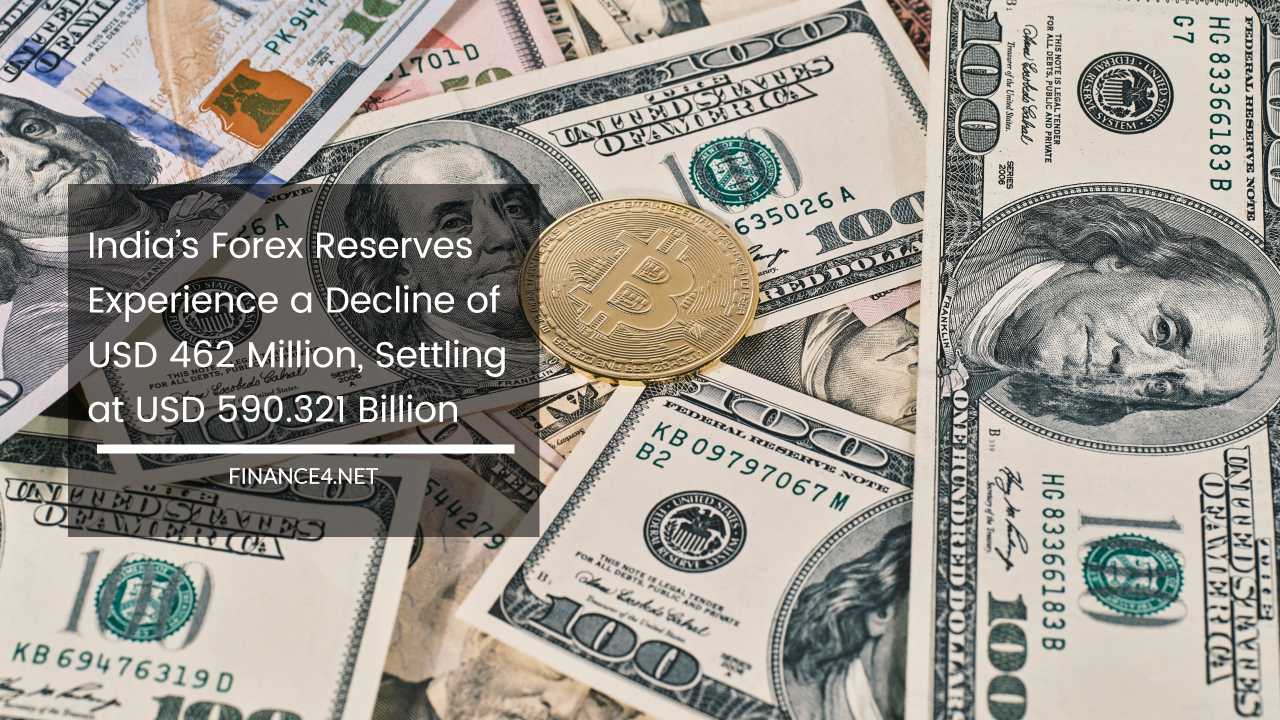India’s Forex Reserves Experience a Decline of USD 462 Million, Settling at USD 590.321 Billion

India’s Forex Reserves
In October 2021, India’s foreign exchange reserves, colloquially known as the forex kitty, achieved an unprecedented milestone by reaching a historic high of USD 645 billion.
However, a recent report from the Reserve Bank of India (RBI) on Friday revealed a decline in the country’s forex reserves by USD 462 million, settling at USD 590.321 billion for the week concluding on November 10.
This marks a noteworthy shift from the previous reporting week when the reserves witnessed a substantial increase of USD 4.672 billion, reaching USD 590.783 billion.
The decrease in reserves can be attributed to the strategic utilization of the forex kitty by the central bank.
The primary objective was to shield the Indian rupee from various pressures, predominantly emanating from global developments that have been unfolding since the preceding year.
For the week ending November 10, the foreign currency assets, a critical component of India’s overall reserves, experienced a modest increase of USD 108 million, reaching a total of USD 522.004 billion.
This information is gleaned from the Weekly Statistical Supplement released by the RBI. The foreign currency assets, expressed in dollar terms, encompass the effects of the appreciation or depreciation of non-US units, such as the euro, pound, and yen, held in the foreign exchange reserves.
The dynamics of the forex reserves are intricately linked to the central bank’s intervention in currency markets, especially during times of heightened volatility.
The forex reserves serve as a buffer, enabling the central bank to navigate fluctuations in the currency’s value effectively.
In this context, the recent decrease in reserves signifies the active role played by the RBI in responding to external economic challenges.
The reduction in forex reserves comes after a period of sustained growth that saw India’s reserves reaching historic highs.
The forex reserves act as a crucial indicator of a country’s economic stability and its ability to meet its international obligations. In the case of India, the recent fluctuations highlight the delicate balance between deploying reserves for currency defense and maintaining a robust financial position.
Breaking down the components of the reserves, the foreign currency assets, which constitute a substantial portion, demonstrated a measured increase.
During the week ending November 10, these assets grew by USD 108 million to USD 522.004 billion. This increase reflects the ongoing efforts to manage currency values amid global uncertainties.
The foreign currency assets are sensitive to changes in the valuation of non-US currencies, and their growth is indicative of the central bank’s adept management of the forex reserves.
Gold reserves, another significant element of India’s reserves, experienced a decline of USD 608 million during the same week, reaching USD 45.515 billion.
Gold reserves play a dual role, acting as a store of value and a hedge against economic uncertainties. The decrease in gold reserves could be attributed to various factors, including changes in global gold prices and strategic decisions by the central bank to rebalance the composition of the reserves.
The Special Drawing Rights (SDRs), an international reserve asset created by the International Monetary Fund (IMF), recorded a marginal increase of USD 36 million, reaching USD 18.011 billion.
SDRs play a supplementary role in a country’s reserves, providing liquidity and serving as a reserve diversification tool. The increase in SDRs suggests a nuanced approach to managing the composition of reserves to enhance overall stability.
India’s reserve position with the IMF, which represents the country’s holding of its own currency within the IMF, witnessed a rise of USD 3 million during the reporting week, reaching USD 4.791 billion.
This component reflects India’s participation in the international monetary system and its commitment to the objectives of the IMF.
The fluctuations in India’s forex reserves underscore the challenges faced by emerging economies in navigating the complex global economic landscape.
The country’s reserve management strategy involves a delicate balance between maintaining an adequate cushion for external shocks and deploying reserves judiciously to support the domestic economy.
The central bank’s decision to utilize the forex kitty for defending the rupee highlights the interconnectedness of global financial markets and the need for proactive measures to safeguard national economic interests.
As the global economic landscape continues to evolve, with geopolitical developments and monetary policy shifts influencing currency values, the role of forex reserves in ensuring financial stability becomes increasingly pivotal.
It’s important to note that the data provided by the RBI reflects a snapshot of the country’s economic position at a specific point in time.
The fluctuations in reserves are part of a dynamic process influenced by both domestic and international factors. The central bank’s ability to adapt its strategies in response to changing circumstances is a testament to its role as a key guardian of India’s economic stability.
In conclusion, the recent decrease in India’s forex reserves, following a period of remarkable growth, underscores the nuanced challenges faced by the country in maintaining financial stability amid global uncertainties.
The central bank’s proactive management of the forex reserves, as evidenced by the deployment of the reserves to defend the rupee, reflects a strategic approach to safeguarding the country’s economic interests.
As the global economic landscape continues to evolve, the resilience of India’s economy will depend on its ability to navigate these complexities while ensuring a prudent and effective management of its forex reserves.



